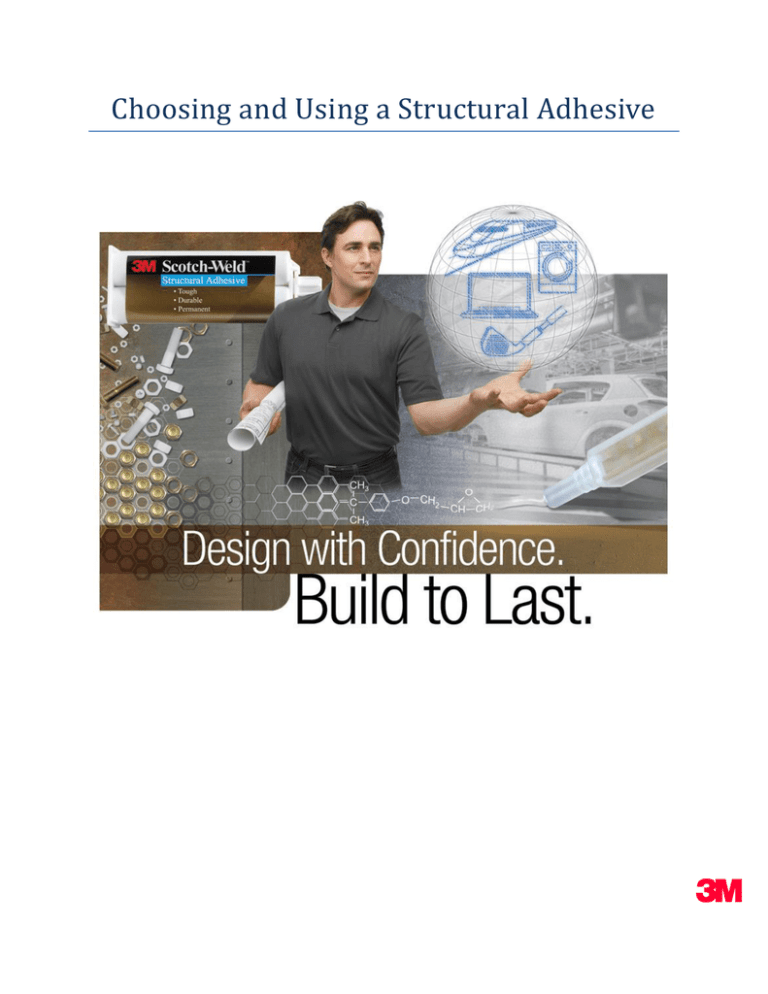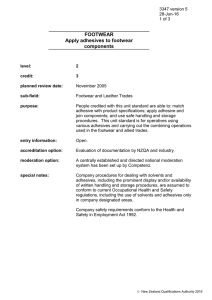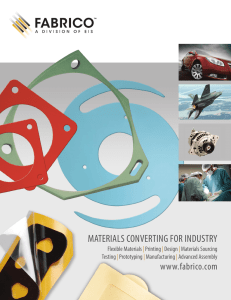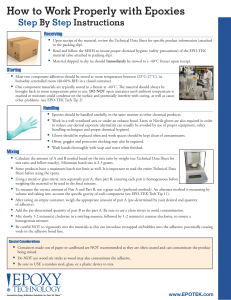Choosing and Using a Structural Adhesive
advertisement

Choosing and Using a Structural Adhesive Why use a Structural Adhesive? Structural adhesives are chosen for a multitude of assembly operations. Unlike mechanical fastening methods, they don’t damage substrates (i.e. no need to drill holes; no heat distortion as when welding metal); they can join dissimilar materials without galvanic corrosion; are amenable to a number of different geometries; don’t concentrate stress at a few localized spots (thus increasing fatigue resistance); and don’t require refinishing steps or leave protrusions (aesthetically more pleasing). Structural adhesives also play an important role in the move to composite materials, which allow for significant weight reduction with comparable stiffness, compared to metals. Composites are generally not amenable to solvent welding, and drilling can damage parts; accordingly, structural adhesives are an excellent joining technology for these materials. Compared to other types of adhesives, structural adhesives have the highest load bearing capability; excellent environmental and chemical resistance; are generally formulated to be 100% solids (no solvent emissions to deal with); and come in a range of cure times and properties. Structural adhesives cure in an irreversible process which helps provide excellent temperature and solvent resistance. They do not need access to air to dry; nor moisture (like one-part silicone and polyurethane sealants); and thus have unlimited depth of cure. In fact, there are so many characteristics and applications for structural adhesives that an engineer may have difficulty selecting which structural adhesive to use! This paper will attempt to provide some clarity around the decision. Compared to other adhesives, however, structural adhesives are less intuitive to use and can their performance can be widely affected by processing decisions. These issues will be addressed later in the paper. Figure 1: Adhesive technology families. Different types of adhesives vary significantly in their loadbearing capability (strength); ranging from familiar technologies such as pressure sensitive adhesives frequently applied to tapes, up through various liquid adhesive technologies (hot melts for example); with epoxy adhesives generally being the strongest category of adhesive. This chart deals only with loadbearing capabilities; non-structural adhesives have a lot to offer in terms of convenience and load isolation functions. This paper will focus on structural adhesives which have the highest load-bearing capability amongst types of adhesives. Selecting a Structural Adhesive In choosing a structural adhesive, consultation with an expert (such as a technical engineer at a supplier or an outside consultant) is invaluable. But, in some cases preliminary decisions may be made prior to more specific discussions, or perhaps the applications are too sensitive to discuss with a range of outside experts. In that case, general principles for choosing a structural adhesive can be observed by the engineer. Regardless of the route(s) chosen to select structural adhesives to test, the key is testing—no final decision should be made without specific validation testing. However, key principles can be used to select a set of adhesives to test. Structural adhesives should be chosen with the end use requirements firmly in mind. Once these are known, the proper adhesive can be selected by matching the requirements to the different processing and performance characteristics of different structural adhesives. In particular, end use conditions to consider include: • • • • Expected conditions during End Use: – Temperature – how hot? how cold? – Humidity – will the material be exposed to rain? To salt water? – UV exposure – will the joint be exposed to the sun and can the UV penetrate the substrates to reach the adhesive? Chemical resistance required: – Fluids (motor oil, gasoline, diesel fluid, jet fuel) – will these contact the joint? – Cleaning solutions (weak acids and bases) – will the joint be cleaned frequently? – Are there specialized chemicals which may contact the bonded part? – Will contact be continual (e.g. in a filtering assembly) or only occasional? Cleanliness / Environmental issues during production and end use: – Outgassing, ionics, corrosion potential—is the part being bonded sensitive to these issues (for example, electronics or optics) – toxicity, disposal – are there regulations that come into play? Will the adhesive be used in food packaging or a medical device? Mechanical Challenges – Impact, vibration, fatigue– will the bonded part be subject to high impact or vibrational forces in use? What about thermal cycling and dis-similar coefficient of thermal expansion substrates? – Stress type and magnitude – how high are the stresses on the bondline? What types of stresses will the bondline experience (NB: this is a very involved question that will be further addressed in another paper in this series.) The general answers to the above questions (is solvent resistance a consideration? Will the part be subject to ongoing vibrations?) Will help determine which type of structural adhesive should be considered; while the specific answers to the questions (how many degrees of temperature does the adhesive experience in end use? How many pounds of weight must the joint support?) Will help determine which specific products should be chosen based on the manufacturer’s data sheets and application test results. Types of Structural Adhesives and Their Performance Criteria Structural adhesives can be generally categorized by chemistry. For the purposes of this paper, we will define “structural” adhesives as those routinely capable of overlap shear strengths in excess of 1000 psi when bonding metal and testing at room temperature. Although hybrid products can be formed, in general the categories of structural adhesives are: Epoxies (one and two part formulations); Acrylics (two-part and two-step formulations); Urethanes (two part formulations); and Cyanoacrylates (“instant adhesives”). Certainly each type of chemistry can be tailored to some extent, but it is also possible to roughly compare the categories based on the general properties inherent in the chemistry. The chart below shows a rough correlation across the chemistries. Properties can be varied with the addition of numerous additives such as thickeners (to increase viscosity or stiffness), diluents (to decrease viscosity), plasticizers, etc; and specific curatives and accelerators can be used to vary cure times. Engineers are thus cautioned to review the specific properties for adhesives of interest. In general, certain trends hold true: Acrylics overall provide the highest bonding strength on plastics, and may also provide good bonds to metals. However, they tend to have lower vibration/impact resistance than better epoxies (thus, lower fatigue resistance) and lower performance at temperature extremes. They also cure-shrink more than epoxies and urethanes; so they may be less ideal for certain, constrained bond lines. Two-part acrylics tend to bond well through many common stamping and forming oils, so in many cases they may require less surface preparation to use. However, most common products have high odor and contain a flammable material. There are some low-odor products that do not contain the flammable substance, such as 3M™ScotchWeld™ Acrylic Adhesive DP8805NS and DP8810NS; which can provide a more pleasant working environment. Newer acrylic adhesives are shelf-stable up to 18 months at room temperature in a 10:1 mix ratio. Cyanoacrylates tend provide good shear strength on many plastics and rubbers (although primers may be required); but are rigid and show low peel and impact resistance; and are not good for long term applications on metals or glass. Urethanes tend to be quite flexible, but have lower strength in general. They can be relatively good plastic, rubber and composite bonders and generally are lower priced than other categories of structural adhesives. Epoxies come in the widest range of properties and can have the best overall properties on metals and often on thermoset composites. Standard 5 minute rigid epoxies that are commonly available in hardware, tend to be brittle, and are best suited to applications where relatively low stress and no impact are expected. Flexible epoxies, such as 3M™ Scotch-Weld™ Epoxy Adhesive 2216, have higher peel strengths and hence better impact performance; they are also good choices for parts which may require some flex in end use. Toughened epoxies, such as 3M™ Scotch-Weld™ Epoxy Adhesive DP420 and DP460, actually incorporate elastomeric regions which absorb impact, and thus provide the highest shear, peel, impact, vibration and fatigue resistance; and hence are chosen for the most demanding end use applications. In general, however, epoxies require rigorous cleaning of oils from metal joint surfaces for room temperature bonding. Based on these generalities, if an engineer is looking to bond ABS to stainless steel, for a part that will see moderate environmental stress (e.g. -20°F to 150°F, for example) but little vibration or impact, the choices would likely include epoxies and acrylics. Add vibration or impact to the criteria, and the choices would tip towards epoxies or specially toughened acrylics. An engineer seeking to bond wood to plastic for outdoor use, where significant movement of the substrate may occur due to changes in the weather, would consider urethanes for their flexibility; if higher strength is needed a flexible epoxy could be chosen. Bonding a low surface energy plastic (such as HDPE or glass-filled polypropylene) to itself or to another plastic or metal would require a specialty acrylic, such as 3M™ Scotch-Weld™ Structural Plastic Adhesive DP8010 Blue. In some cases, of course, ultimate strength or performance in a property category may not be required. In this case, the engineer may be able to trade off performance for handling and processing capabilities, which will be discussed next. Property Epoxies Acrylics Urethanes Cyanoacrylates Overlap Shear Metals best low to high moderate low for longterm bonding Overlap Shear Plastics moderate best moderate high Overlap ShearThermoset Composites best high high moderate low to best low to (occasionally) high good low poor to best poor to good poor to good poor to good good excellent low low Peel Strength Impact Resistance and Toughness Flexibility Temperature Resistance Range best moderate moderate low Solvent Resistance best moderate high low Figure 2: Structural Adhesive family properties comparison Handling and Processing Considerations Once the engineer has an idea of the adhesives that are likely to meet the end use performance requirements, handling and processing considerations come into play. These run the gamut from storage conditions and shelf life up to the convenience of the assembly process. Again, different chemical types of structural adhesives tend to have different properties as noted in the table below. When discussing handling and processing considerations, it is necessary to distinguish between one-part and two-part epoxies, as they are handled and processed very differently. One-Part epoxies have the curative and base pre-mixed; while this eliminates the need to measure out and mix the parts separately, it also leads to shelf life issues (premature aging and cold temperature storage requirements) and these formulations require high heat curing (typically, 250°F to 350°). Thus, in contrast to two-part epoxies, these one-part epoxies require careful handling, but are relatively easy to dispense, and always require additional heat for cure. In addition, one-part epoxies generally provide the highest shear strengths on metal, and the best high temperature and solvent resistance. Property One-Part Epoxies Two-Part Epoxies Acrylics Urethanes Cyanoacrylates Storage Requirements difficult easy moderate moderate moderate Shelf Life short at room temp long moderate to long moderate moderate Meaure/Mix required? No yes yes yes no Room Temp Cure? Pot Life No very long yes long yes moderate yes moderate yes long Initial cure time not possible without heat moderate to long without heat fast moderate very fast Full Cure Time fast slow unless heat curing slow unless heat curing very fast Odor little some little moderate fast usually strong Figure 3: Structural adhesive family handling and processing comparison For production convenience, cyanoacrylates are often chosen. They do not require mixing and have a very long pot life or open time prior to bonding. Their drawbacks are that once the bonded parts are mated they cannot be repositioned; also, there is some odor inherent in them and the possibility of accidental skin bonding. In addition, for some applications the “blooming” (which is really volatilized monomer that recondenses on parts) tendency of cyanoacrylates may be an issue—3M™ ScotchWeld™ Low Odor Instant Adhesive LO100 and LO1000 have low blooming characteristics. Two-part epoxies, acrylics and urethanes require some amount of time for the cure to start after the parts are mixed and the surfaces to be bonded are mated; this allows positioning but also requires that the parts be fixtured in place until some level of cure has occurred. This period of time is referred to as set time, fixture time, green strength or time to handling strength—in any event, manufacturers define it differently so the engineer needs to carefully consider the data on the datasheet to correctly determine the parameters for each adhesive. Like cyanoacrylates, these adhesives are stable at room temperature prior to mixing; room temperature storage is greatest for two-part epoxies and shortest for urethanes (which are moisturesensitive) and acrylates (which can be temperature-sensitive or gel in the absence of oxygen). Typically, two part adhesives can be supplied in bulk systems, such as 5 gallon pails or 55 gallon drums, and used with a meter/mix system; they may come packaged in hand-dispensable cartridges with the two components side by side (as in the 3M™ EPX™ Duo-Pak system) which assist in proper ratio-ing and mixing, or may come in small cans or tubes which require manual measuring and mixing of the parts. The two-part 3m™ EPX™ Duo-Pak system features two side-by-side cylinders appropriately sized to provide the right mix ratio, and disposable static mix nozzles that ensure proper mixing in use. A variety of hand-held applicators are available as well (see picture below). Figure 4: handheld 3M™ EPX™ Plus II applicator containing a duo-pak cartridge with attached static mix nozzle. A note about curing two-part adhesives: Adhesives that cure by chemical reaction (including all two-part adhesives) are sensitive to the temperature in determining the cure time. At warmer temperatures, they will cure faster (and, in consequence, have shorter pot lives, open times, and times to handling strength). At cooler temperatures, the curing occurs more slowly and the times are extended. Thus, when using the adhesives in a non-temperature controlled environment, the user must consider the temperature difference between the use environment and the standard “room temperature” of 70°-75°F generally used by manufacturers to report the pot life and time to handling strength. As a very rough rule of thumb, if using the adhesive outside on a hot summer day, the open time might be as little as half what is reported on the datasheet; whereas on a cool spring or fall day, when the temperature might be in the low 50°s, these times might be doubled. (An approximate estimation used is that for a 10 °C warmer cure environment the adhesive will have half the open time; conversely, for a 10°C cooler environment, the open time will be doubled.) Accordingly, extra care might be needed to complete the bonding step quickly on a hot day, or extra fixture time may be needed in a cool environment. In addition to the varying cure times, the adhesive will also tend to thin in a warmer environment (the same thing occurs when a person warms honey or maple syrup); and will thicken in a cooler environment. Thickening can also lead to less crosslinking and lower cure strengths; in general, then, two part adhesives are often recommended with an application temperature of 60°F – 80°F and a minimum application temperature around 40°F. A corollary is that these two-part structural adhesives can have the cure time accelerated with the use of heat. Options typically include oven or radiant heat sources. Datasheets and other information from manufacturers will assist the user in determining possible cure schedules. Viscosity may also be an issue; with a range of viscosities present in all types of structural adhesives. In general, the range is widest in the two-part epoxy and urethane categories, where products can range from very thin to heavy pastes. Non-sag adhesives may be formulated to be shear-thinning; this allows them to dispense relatively easily but not to run or sag after dispensing. While structural adhesives typically don’t contain solvents, they may contain volatile organic chemical components or other components that can cause an odor or may lead to skin or respiratory irritation. While these are generally not a problem, users are cautioned to review the Material Safety Datasheets (MSDS) prior to using the adhesives. Summary To choose adhesives to screen, consider first end user requirements. Based on the information above and information from particular manufacturers, choose several adhesives to consider. Then, in conjunction with Product Manufacturing, consider the requirements of the process environment to refine the original adhesive choices. This will result in a relatively small set of adhesives with favorable performance and processing characteristics. For a final selection, however, testing and validation is always recommended. Typically, overlap shear tests of some sort are done to determine the strength of the adhesive on particular substrates or under environmental conditions, and peel tests are also common. The exact details of the test should be based on the particular project; don’t rely solely on the results in the manufacturer’s technical data sheets. A good adhesives supplier will be willing to work with users in defining and assisting in these decisions, including some type of material testing. However, the most carefully chosen adhesive may not give acceptable application performance if the bonding surfaces have not been properly prepared or the joint has been poorly designed. These factors will be addressed in a future paper in this series. Technical Information: The technical information, recommendations and other statements contained in this document are based upon tests or experience that 3M believes are reliable, but the accuracy or completeness of such information is not guaranteed. Product Use: Many factors beyond 3M’s control and uniquely within user’s knowledge and control can affect the use and performance of a 3M product in a particular application Given the variety of factors that can affect the use and performance of a 3M product, user is solely responsible for evaluating the 3M product and determining whether it is fit for a particular purpose and suitable for user’s method of application. Warranty, Limited Remedy and Disclaimer: Unless an additional warranty is specifically stated on the applicable 3M product packaging or product literature, 3M warrants that each 3M product meets the applicable 3M product specification at the time 3M ships the product. 3M MAKES NO OTHER WARRANTIES OR CONDITIONS, EXPRESS OR IMPLIED, INCLUDING, BUT NOT LIMITED TO, ANY IMPLIED WARRANTY OR CONDITION OF MERCHANTABILITY OR FITNESS FOR A PARTICULAR PURPOSE OR ANY IMPLIED WARRANTY OR CONDITION ARISING OUT OF A COURSE OF DEALING, CUSTOM OR USAGE OF TRADE. If the 3M product does not conform to this warranty, then the sole and exclusive remedy is, at 3M’s option, replacement of the 3M product or refund of the purchase price. Limitation of Liability: Except where prohibited by law, 3M will not be liable for any loss or damage arising from the 3M product, whether direct, indirect, special, incidental or consequential, regardless of the legal theory asserted, including warranty, contract, negligence or strict liability. Industrial Adhesives and Tapes Division 3M Center, Building 225-3S-06 St. Paul, MN 55144-1000 800-362-3550 • 877-369-2923 (Fax) www.3M.com/adhesives 3M and Scotch-Weld and EPX are trademarks of 3M Company. © 3M 2012



